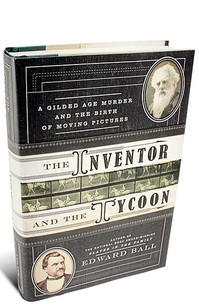Source of book image: online version of the WSJ review quoted and cited below.
(p. A13) Wish it though we might, this strangely off-center Briton isn’t really the Father of Hollywood, nor even a distant progenitor of “Avatar.” The famous time-lapse images that he took for Stanford, proving that a horse does take all four hoofs off the ground while galloping–and the tens of thousands of photographs that he went on to make of birds flying and people sneezing or bending over and picking things up–were soon so comprehensively overtaken by newer technologies (lenses, shutters, celluloid) that his stature as a proto-movie-maker was soon reduced to a way-station. His contribution was technically interesting but hardly seminal at all. The tragic reality is that Thomas Edison, with whom Muybridge was friendly enough to propose collaboration, retains the laurels–though, as Mr. Ball points out with restrained politeness, Muybridge might have fared better had he been aware of Edison’s reputation for “borrowing the work of others and not returning it.”
For the full review, see:
SIMON WINCHESTER. “BOOKSHELF; Lights, Camera, Murder; The time-lapse photos Muybridge took in the 19th century were technically innovative, but they didn’t make him the Father of Hollywood.” The Wall Street Journal (Thurs., February 6, 2013): A13.
(Note: the online version of the review has the date February 6, 2013.)
The book under review is:
Ball, Edward. The Inventor and the Tycoon: A Gilded Age Murder and the Birth of Moving Pictures. New York: Doubleday, 2013.


